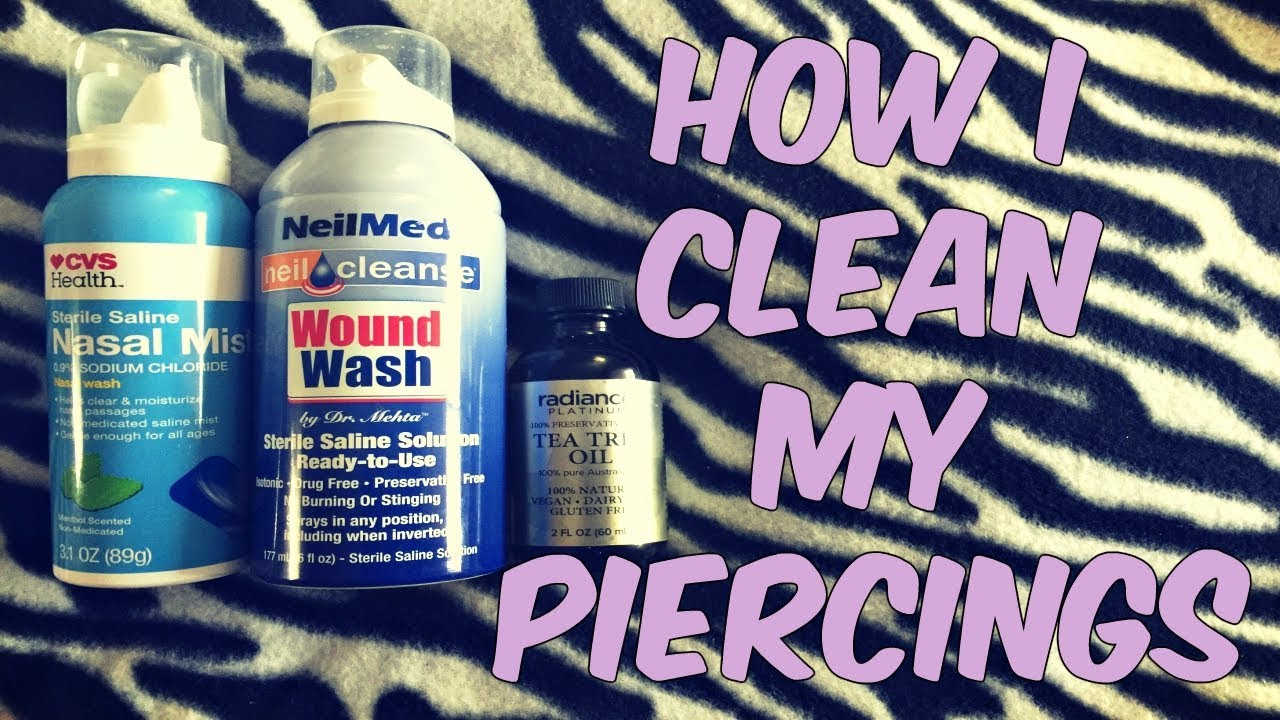What Are Nose Piercing Bumps?
Below are the five main causes of bumps around the site of a nose piercing:
>> Click here to know more about Nose Piercing Bump <<
Nose Pustule
As its name indicates, this nose bump is full of pus. Think of a pustule as a pimple or a blister at the piercing site. Sometimes, they are caused by mild infections. Other times, they are caused by trauma, such as in your piercing being tugged at or pulled on.
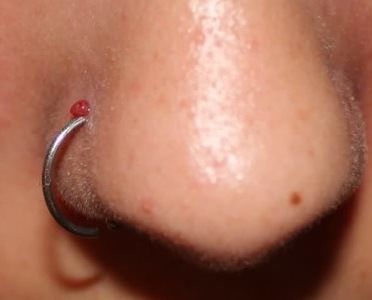
Nose Granuloma
The timetable of when your piercing was done can help you figure out if you’re dealing with a granuloma. They won’t happen immediately after a nose piercing. On average, it takes about 6 weeks until these nuisances show up.
Granulomas can show up in your piercing hole or right next to it. They can be as small as just a couple of millimeters or they can be as big as a couple of centimeters.
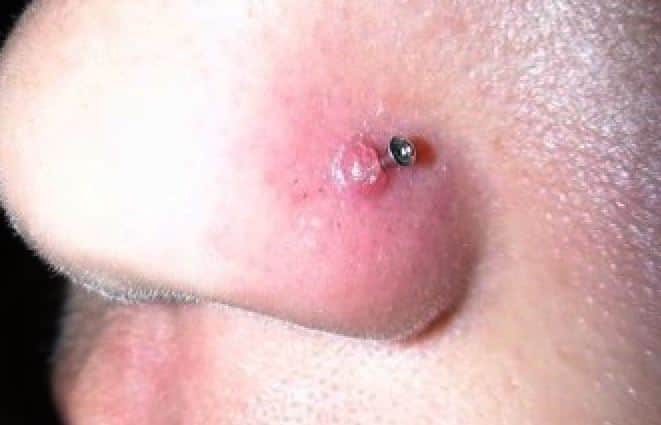
Granulomas form when healing tissue composed of blood vessels around the piercing keeps overgrowing, and are caused by trauma or the inflammatory response your body is producing to deal with the piercing wound, which it sees as an unwelcome intrusion.
Nose Keloid
A keloid is a fancy term for an overgrown scar. Though it’s no ordinary scar – it’s like a scar on steroids. Keloids are really thick and are often quite noticeable. Unlike other forms of scaring, keloids can keep growing upwards and outwards through neighboring tissue, so it’s best to get them evaluated by a Board Certified Dermatologist as soon as possible if you’re concerned.
If you see a formation around your piercing site and you aren’t sure if it’s a keloid, schedule an appointment with your doctor or piercer. They’ll have seen enough keloids and temporary hypertrophic scarring to know the difference between the two.
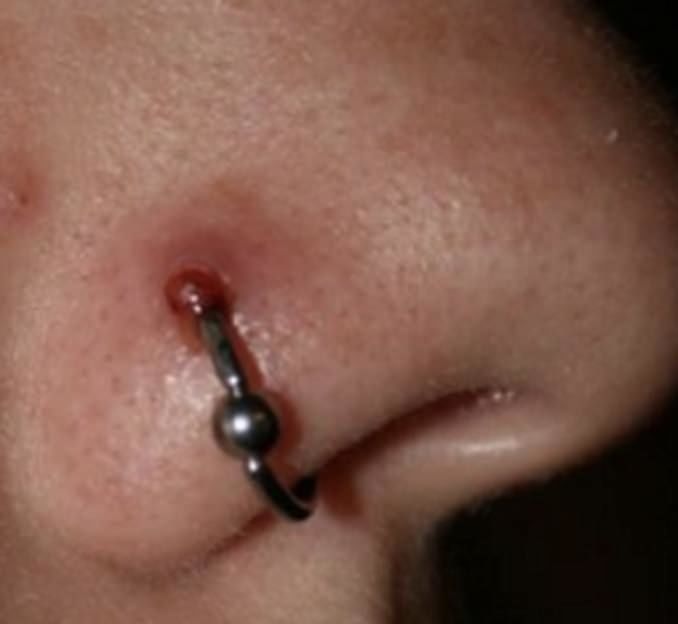
Nose Infection
Sometimes, bacteria can get in the wound and cause an infection, which in turn can cause a lump to form as the body tries to fight and force out the infection-causing bacteria.
Nose Excessive Swelling
Sometimes, inflammation and swelling can cause a small bump to form around the area. If there isn’t an infection present then the bump shouldn’t take too long to go down.
What causes a nose piercing bump?
A raised area around the piercing may be caused by:
- tissue damage — if the piercing gets knocked or is removed too early
- infection — if the piercing is done in unsanitary conditions or is not kept clean
- an allergic reaction to the jewelry
- trapped fluid creating a lump or bump
- a keloid, which is a type of raised scar
- a granuloma, which is inflamed tissue that usually appears as a raised, reddish spot
- Keloids are relatively uncommon and should be diagnosed and treated by a doctor or dermatologist.
A keloid around a piercing will appear as a round, raised bump that is darker than the surrounding skin. It may cause pain, itching, or tenderness and will feel firm to the touch.
A granuloma can form as the body’s immune system tries to fight off something it thinks may harm the body. Usually, this is bacteria or a virus that could cause an infection, but it can also be a reaction to the jewelry itself.
If a person has their nose pierced under hygienic conditions and follows proper aftercare recommendations, it should heal without a bump. A nose piercing can take 4 to 6 months to heal and will need to be cleaned regularly during this period.
How to Treat Your Nose Piercing Bump?
If you have an infection, go see your doctor. Otherwise, you can attempt to treat it at home using:
Change your jewelry
Jewelry is often made with metal nickel. This can trigger an allergic reaction in some people, causing a bump to form.
- Other symptoms include:
- intense itchiness
- redness and blistering
- dry or thickened skin
- discolored skin
The only solution is to replace your jewelry with a ring or stud made with hypoallergenic material. If you’re sensitive to nickel, the best materials for jewelry are:
- 18- or 24-karat gold
- stainless steel
- titanium
- niobium
If your nose piercing is less than 6 months old, you shouldn’t swap your jewelry out on your own. Doing so may cause your nose tissue to tear. Instead, visit your piercer so they can swap out the jewelry for you.
Once you’re past the 6-month healing point, you can change the jewelry yourself if you feel comfortable doing so. If you’d prefer, your piercer can do it for you.
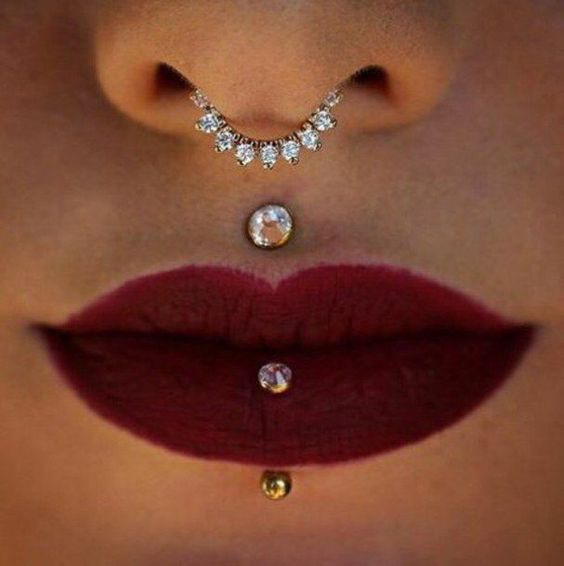
Make sure to clean your piercing 2 to 3 times a day
New piercings should usually be cleaned two to three times per day. Your piercer can provide you with a more specific recommendation.
Before touching your nose piercing for any reason, you should always wash your hands thoroughly using warm water and liquid soap. Dry your hands with a paper towel, then proceed to clean your piercing.
Your piercer can recommend specific cleansers to use. They’ll likely advise against using triclosan-containing soaps to clean your piercing, as they can dry out the surrounding skin. Other products to avoid include:
- iodopovidone (Betadine)
- chlorhexidine (Hibiclens)
- isopropyl alcohol
- hydrogen peroxide
You should also avoid:
- picking any crust that forms around your piercing
- moving or spinning your ring or stud when your piercing is dry
- using topical ointments on the area, as these block air circulation
- It’s important to clean the piercing every day for the first 6 months. Even if your piercing looks like it’s healed from the outside, tissue on the inside of your nose may still be healing.
Apply diluted tea tree essential oil
Tea tree is a natural antifungal, antiseptic, and antimicrobial agent. Tea tree oil is especially useful to dehydrate a nose-piercing bump. It also helps to boost the healing process, ward off infection, and reduce inflammation.
But beware: Tea tree oil can cause a reaction. If this is your first time using it, do a patch test before applying it to an open wound like your nose piercing. To perform a patch test:
- Apply a small amount of diluted tea tree oil to your forearm.
- Wait at least 24 hours.
- If you don’t experience any irritation or inflammation, you can apply the solution to your nose piercing.
- To make a tea tree solution, simply add two to four drops of tea tree oil to approximately 12 drops of carrier oil, such as olive oil, coconut oil, or almond oil. The carrier oil will dilute the tea tree oil, making it safe to use on your skin.
Use a chamomile compress
Chamomile contains compounds that help wounds heal faster and stimulate the skin’s barrier to restore itself. You can alternate between using a salt solution and a chamomile solution. To make a warm chamomile compress:
- Soak a chamomile tea bag in a cup, as you would if you were making a cup of tea.
- Leave the bag to steep for 3 to 5 minutes.
- Soak a piece of paper towel in the chamomile solution and apply to your piercing for 5 to 10 minutes.
- To retain the warmth, soak a new piece of paper towel and reapply every 2 minutes or so.
- You shouldn’t use chamomile if you have a ragweed allergy.
Clean with a sea salt soak
Wash your hands thoroughly using warm water and liquid soap. Dry using a paper towel.
Unless your piercer has recommended special soap, you should use a salt solution to clean your piercing. Make your solution by adding 1/4 teaspoon of non-iodized sea salt to 8 ounces of warm water. Then:
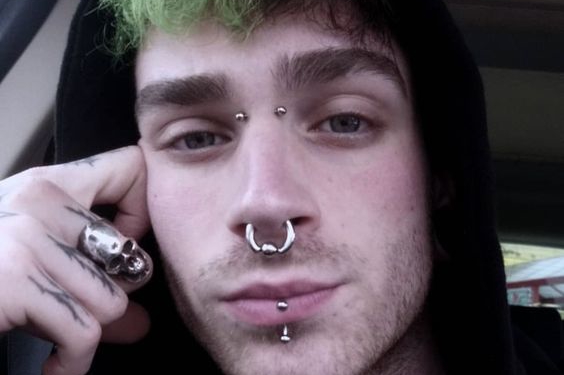
- Soak a piece of paper towel in the salt solution.
- Hold the saturated paper towel over your nose piercing for 5 to 10 minutes. This is called a warm compress and will soften any crust or discharge surrounding your piercing. It may sting a little.
- You may want to reapply a new piece of soaked paper towel every 2 minutes or so to keep the area warm.
- After the compress, use a clean cotton bud dipped in the salt solution to gently remove any moistened crust or discharge from the inside and outside of your nose piercing.
- You can also soak a new piece of paper towel in the salt solution and squeeze over the area to rinse it.
- Use a clean piece of paper towel to gently pat the area dry.
- Repeat this process two or three times per day.
Whatever you do, do not take out the jewelry yourself for a long time. Clean properly around it, instead, or the piercing will close up. While pustules can be treated at home, a keloid or a granuloma often require medical intervention.
How To Get Rid Of Nose Piercing Bumps?
Five ways to get rid of a nose piercing bump
The best way to get rid of a nose-piercing bump depends on what caused it. Read on to learn about some home remedies that can help.
Use proper aftercare
Proper aftercare should prevent damage to tissue or an infection that could cause a bump. The piercer should advise on how to look after a piercing, which usually involves cleaning it regularly. Tips for caring for a nose piercing include:
- cleaning the area with a saline solution twice a day
- not removing jewelry before a nose piercing has healed, which can take 4–6 months
- avoiding moving jewelry, playing with it, or knocking the piercing while getting dressed
- covering the nose piercing with a waterproof dressing when swimming to prevent contact with bacteria in the water
- not using lotions, cosmetics, or hair care products near the piercing
- Use hypoallergenic jewelry
Some people are allergic to certain metals, usually nickel or an alloy, which is a mixture of a metal and another element. If a red itchy rash appears or the piercing feels sore for a long time, it may be an allergy.
If jewelry is causing an allergic reaction, it should be replaced with hypoallergenic jewelry that will not react with the body. Reputable piercers should use jewelry made from an appropriate material, such as surgical steel or titanium.
Use a sea salt solution
A sea salt solution is a natural way to keep the piercing clean, help it heal, and reduce any swelling that may be causing an unsightly bump.
A person can dissolve ⅛ to ¼ of a teaspoon of sea salt in 1 cup of warm distilled or bottled water, rinse the piercing with the solution, then gently pat it dry. People should be sure to wash their hands thoroughly beforehand to lower the risk of infection.
Try tea tree oil
Some piercers recommend using tea tree oil to dehydrate and shrink a piercing bump. Although there is limited research available on the effectiveness of tea tree oil, it is safe for most people to use directly in the area.
If you want to buy tea tree oil, then there is an excellent selection online with thousands of customer reviews.
Apply a warm compress
Trapped fluid under the skin can cause a bump, but heat and pressure will help gradually drain it.
A simple warm water compress can be made by soaking a clean washcloth in hot water, applying it to the piercing, and holding it there with gentle pressure for a few minutes.
A person should not try to force the bump to drain, as this can lead to further irritation and scarring.
Ten articles before and after
Which Side Should I Pierce My Nose?
Will My Ear Piercing Close Up Overnight?
Rhodium Plated Sterling Silver
Does Stainless Steel Turn Green?
Crooked Septum Piercing & 29 Things You Need To Know About The Septum Piercing

